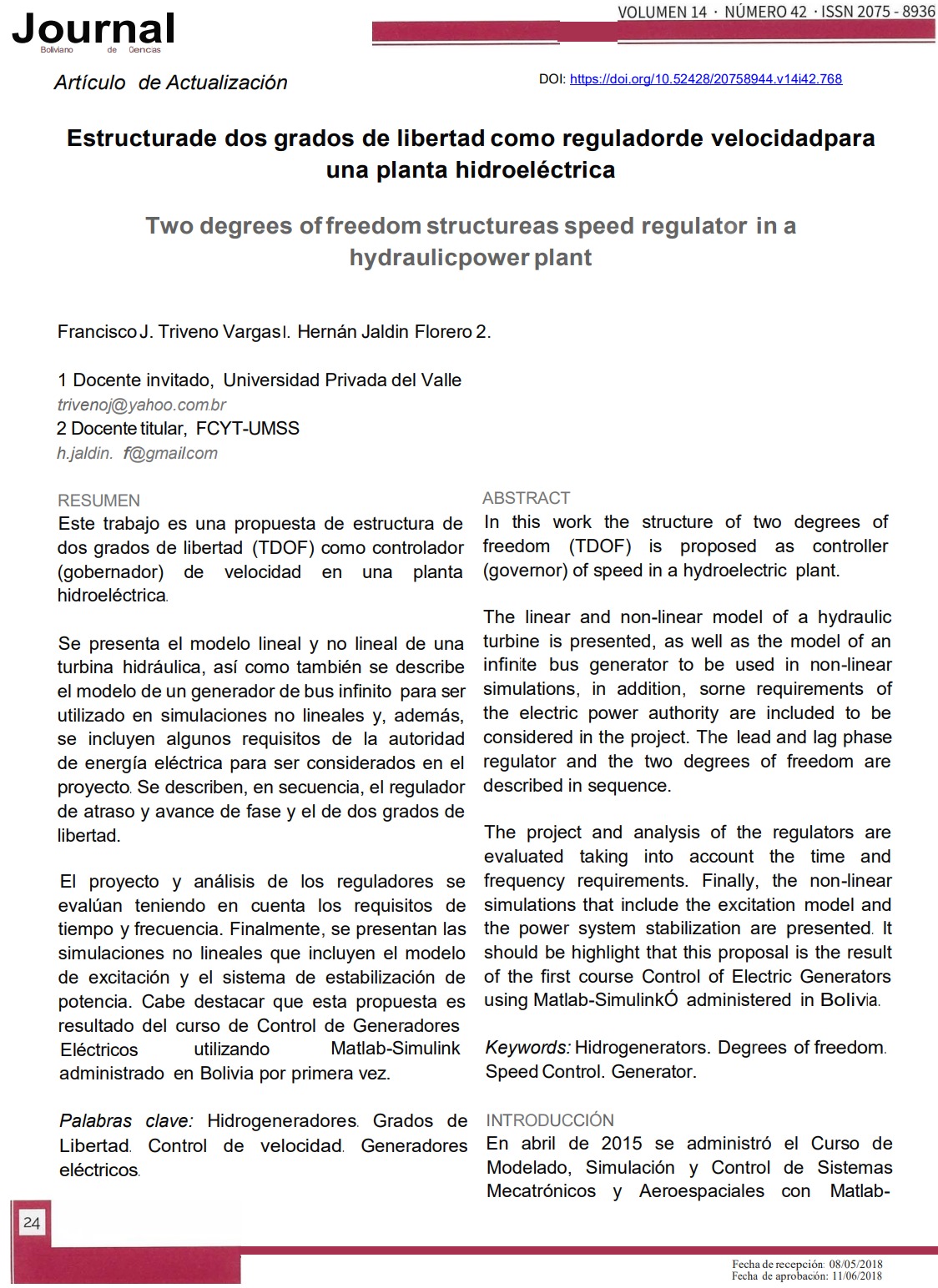Two Degrees of Freedom Structure as Speed Regulator in a Hydraulic Power Plant
DOI:
https://doi.org/10.52428/20758944.v14i42.768Keywords:
Hidrogenerators, Degrees of Freedom, Speed Control, GeneratorAbstract
In this work the structure of two degrees of freedom (TDOF) is proposed as controller (governor) of speed in a hydroelectric plant. The linear and non-linear model of a hydraulic turbine is presented, as well as the model of an infinite bus generator to be used in non-linear simulations, in addition, sorne requirements of the electric power authority are included to be considered in the project. The lead and lag phase regulator and the two degrees of freedom are described in sequence. The project and analysis of the regulators are evaluated taking into account the time and frequency requirements. Finally, the non-linear simulations that include the excitation model and the power system stabilization are presented. lt should be highlight that this proposal is the result of the first course Control of Electric Generators using Matlab-SimulinkÓ administered in Bolivia.
Downloads
References
(1) Alavi, S. y Saif, M . (2013). On stability analysis by using Nyquist and Nichols Charts. (lera edición) Canadá: University of Windsor.
(2) IEEE, C. R. (1981). Excitation system models for power system stability studies. EE. U U.: IEEE Transactions on Power Apparatus and Systems, pp. 494-509. https://doi.org/10.1109/TPAS.1981.316906
(3) Kundur, P. {1993). Power System Stability and Control. (lera edición) New York: McGraw-Hill.
(4) Machowski, J., Bialek, J. y Bumby, J. (2008). Power System Dynamics: Stability and Control. (lera edición) Reino Unido: Wiley and Sons.
(5) Naghizadeh, R. A., Jazebi, S. y Vahidi, B. (2012). Modeling hydro power plants and tuning hydro governors as an educational guideline. Italia: lnternational Review on Modeling and Simulations 5(4): 1780-1790.
(6) Padiyar, K. {2008). Power System Dynamics: Stability and Control. (2da edición) India: BS Pu blications.
(7) Vargas, F. J. T., de Pieri, E. R. y Castelan, E. B. (2004). ldentification and friction compensation for an industrial robot using two degrees of freedom controllers. China: ICARCV, I E E E , pp. 1146-1151. https://doi.org/10.1109/ICARCV.2004.1469006
(8) Vargas, F. J. T. y Paglione, P. (2015). Ferramentas de Álgebra Computacional: Aplicacóes em Modelagem, Sirnulacáo e Controle para Engenharia. (lera edición) Brasil: LTC.
(9) Wolovich, W. A. {1994). Automatic Control Systems: Basic Analysis and Design. (2da edición) Reino Unido: Oxford University Press.

Downloads
Published
How to Cite
Issue
Section
License
Copyright (c) 2018 Francisco J. Triveno Vargas y Hernán Jaldin Florero

This work is licensed under a Creative Commons Attribution 4.0 International License.
Authors who publish with this journal agree to the following terms:
- Authors retain copyright and grant the journal right of first publication with the work simultaneously licensed under a Creative Commons Attribution License 4.0 that allows others to share the work with an acknowledgement of the work's authorship and initial publication in this journal.
- Authors are able to enter into separate, additional contractual arrangements for the non-exclusive distribution of the journal's published version of the work (e.g., post it to an institutional repository or publish it in a book), with an acknowledgement of its initial publication in this journal.
- Authors are permitted and encouraged to post their work online (e.g., in institutional repositories or on their website) prior to and during the submission process, as it can lead to productive exchanges, as well as earlier and greater citation of published work.














